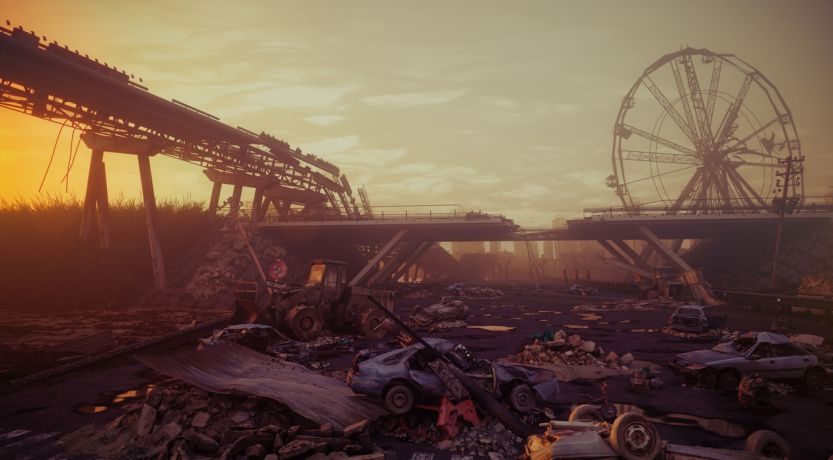In recent decades, the threat of human extinction has become increasingly worrisome. Is there anything we can do to prevent self-destruction? Is there hope?

Humanity has achieved amazing technological progress, which has only accelerated in recent history. Our world has been transformed by the industrial revolution, the atomic age, the space age, the information age, genetic engineering, artificial intelligence and much more.
Yet too often scientific progress has come at the expense of the planet and even with threats to our own existence. Our knowledge has outstripped our ability to foresee and control these dangers.
Toby Ord wrote in his book The Precipice: Existential Risk and the Future of Humanity:
“Yet humanity’s wisdom has grown only falteringly, if at all, and lags dangerously behind. Humanity lacks the maturity, coordination and foresight necessary to avoid making mistakes from which we could never recover. As the gap between our power and our wisdom grows, our future is subject to an ever-increasing level of risk” (2020, pp. 3-4).
Existential risk
The Bulletin of the Atomic Scientists began in the aftermath of World War II under the shadow of the atomic bomb. Throughout the time since, the organization has moved its Doomsday Clock closer to or farther from midnight as the perception of existential danger—threats to our existence—rose or waned.
Now at 100 seconds, the clock is as close to midnight as it has ever been, and no longer just because of nuclear threats.
And it’s not just the scientists who are sensing the danger. A 2021 article in the Bulletin reported:
“Several years ago, a team of Australian researchers asked people in the United States, the United Kingdom, Canada, and Australia about how probable a global catastrophe in the near term might be. They found that ‘a majority (54 percent) rated the risk of our way of life ending within the next 100 years at 50 percent or greater, and a quarter rated the risk of humans being wiped out at 50 percent or greater’” (“Scared Straight: How Prophets of Doom Might Save the World”).
A search for “human extinction” shows a significant leap in the frequency of the term’s use over the past 20 years.
The article pointed out that many scholars who study existential threats agree that “the probability of doom is higher today than ever before.”
Nuclear weapons, killer drones, designer pathogens, artificial intelligence—humanity is developing ever-more efficient methods of destroying civilization or causing our extinction.
“Lord Martin Rees, a world-renowned cosmologist at the University of Cambridge, estimates that human civilization has a 50/50 chance of making it through this century intact.”
Drumbeat of doom
With all the talk about global catastrophic risks, of course there is the danger that people will react with depression and defeatism.
“Also threatening that future? Our recently acquired abilities to destroy each other with nuclear weapons and lethal synthetic biology.”
The Bulletin article mentions psychologist Steven Pinker’s worries that the “drumbeat of doom” will backfire: “Humanity has a finite budget of resources, brainpower, and anxiety.” When these are used up, the result may be a paralyzing sense that humanity is doomed. And if humanity has no hope, then “why sacrifice anything to reduce potential risks? Why forgo the convenience of fossil fuels, or exhort governments to rethink their nuclear weapons policies? Eat, drink, and be merry, for tomorrow we die!” (from his book Enlightenment Now!).
What will cause human extinction?
Stanford Earth Matters magazine published an interview with epidemiologist Stephen Luby titled “What’s Likely to Cause Human Extinction—and How Can We Avoid It?”
Dr. Luby, the director of research for Stanford’s Center for Innovation in Global Health, gave a talk titled “Can Our Collective Efforts Avert Imminent Human Extinction?”
In the end, Dr. Luby believes we can. “But along the way and without intervention, the future looks pretty grim. By 2100 . . . he sees three potential outcomes: human extinction, the collapse of civilization with limited survival, or a thriving human society . . .
“‘Without a thriving biosphere, there is no human future,’ Luby said.
“Also threatening that future? Our recently acquired abilities to destroy each other with nuclear weapons and lethal synthetic biology. As an example, CRISPR, a gene-editing technology, could be a force for good used to help eradicate disease or it could potentially be used to cause harm, such as by genetically modifying bird flu to become airborne. And, as Luby sees it, ‘There’s no shortage of sociopaths.’
“Potential danger also lurks in the acceleration of artificial intelligence.”
Drilling down on one of the risks, LiveScience.com reported:
“The misuse of biotechnology is another existential risk that keeps researchers up at night. This is technology that harnesses biology to make new products. One in particular concerns Cassidy Nelson: the abuse of biotechnology to engineer deadly, quick-spreading pathogens. ‘I worry about a whole range of different pandemic scenarios. But I do think the ones that could be man-made are possibly the greatest threat we could have from biology this century,’ she said.”
Of course, humanity is not the only endangered species. Our rush to self-destruction is taking many other life-forms with us. Scientists believe there have been five previous mass extinctions, each accounting for a loss of more than 70 percent of all species on earth.
In the paper, 17 prominent scientists cite more than 150 studies, concluding that it is now “scientifically undeniable” that humanity is “on the path of a sixth major extinction,” reported the Times of San Diego.
Extinction Rebellion and frustration
Such frightening scenarios have caused many to look away, bury their heads in the sand or be paralyzed by fear. But it has provoked a few to zealous activism. One such group in the news is Extinction Rebellion.
BBC reported: “Extinction Rebellion describes itself as an international ‘non-violent civil disobedience’ movement.
“It says life on Earth is in crisis and facing a mass extinction. It wants governments to declare a ‘climate and ecological emergency’ and take immediate action.”
The group has over 400,000 followers on Facebook, and thousands have been arrested during its protests in London, which included blocking traffic and protesters locking or gluing themselves to roads and buildings.
Who supports Extinction Rebellion? BBC explained, “Among 18 to 24-year-olds, 41% either ‘strongly supported’ or ‘somewhat supported’ the disruption of traffic and public transport in London to highlight Extinction Rebellion’s aims. That compared with 33% of those aged 50-65 and just 26% of over-65s.”
Extinction Rebellion protesters express frustration at the slow pace of change in governments dealing with the crisis. Many other people, especially among the older generations, feel frustration about the disruptions the protesters have caused.
But neither Extinction Rebellion nor its opponents provide a realistic solution to the overwhelming challenges facing humanity. It’s no wonder that hopelessness is becoming widespread.
Doomers and hopelessness
According to Knowyourmeme.com, the Doomer meme first appeared in 2018 and is “typically characterized as an early 20’s male who suffers from depression and has a bleak outlook on the world” and is at risk of opioid addiction.
Kaitlyn Tiffany wrote in The Atlantic that doomers are young men who “are no longer pursuing friendships or relationships, and get no joy from anything because they know that the world is coming to an end.”
Doomer has come to describe someone who recognizes global problems, but sees no solution or way to avoid catastrophe. It’s a response of hopelessness—perhaps the most personally dangerous of all.
Doomsday preppers and futility
An older response to the threat of catastrophe is to stockpile supplies and find a bunker where you can hunker down and try to survive the aftermath.
While emergency supplies are always good to have, the feverish focus on personal survival (often backed by weapons to keep the neighbors away) does nothing to solve the underlying global problems.
And we believe the doomsday prepper approach does not really involve the kind of preparation that is truly needed. (See “Can You Really Prep for Doomsday?”)
Who will prevent human extinction?
Nearly 2,000 years ago the Bible predicted that humanity would reach the precipice of self-destruction in the end time.
It’s not just in recent years that the threat of human extinction has been recognized.
Nearly 2,000 years ago the Bible predicted that humanity would reach the precipice of self-destruction in the end time. Jesus said, “For then there will be great tribulation, such as has not been since the beginning of the world until this time, no, nor ever shall be” (Matthew 24:21).
The Bible describes wars, famines, disease epidemics, earthquakes, persecution, captivity and oppression worse than any time before in history—and that is saying a lot. Human brutality and depravity have often been on display through history. But this will be worse.
Jesus added, “And unless those days were shortened, no flesh would be saved” (verse 22).
We will be on the brink of human extinction!
But the good news of the Bible is that Jesus Christ promises to return and turn things around.
Jesus Christ returns and rescues humanity
Luke dramatically describes the final events of this troubled age and the beginning of a new world:
“And there will be signs in the sun, in the moon, and in the stars; and on the earth distress of nations, with perplexity, the sea and the waves roaring; men’s hearts failing them from fear and the expectation of those things which are coming on the earth, for the powers of the heavens will be shaken. Then they will see the Son of Man coming in a cloud with power and great glory. Now when these things begin to happen, look up and lift up your heads, because your redemption draws near” (Luke 21:25-28).
Jesus will return to bring not only spiritual redemption, but “times of refreshing” and the “restoration of all things” (Acts 3:19-21).
At the end of this age of human misrule, it will be announced that “the kingdoms of this world have become the kingdoms of our Lord and of His Christ, and He shall reign forever and ever!” (Revelation 11:15).
In contrast to this troubled world, His Kingdom will be a Kingdom of justice and peace, of health and prosperity and real joy (Isaiah 2:2-4; 35:1-10).
Our part in preventing human extinction
Though the real solution to preventing human extinction is outside of our control, God does give His people a part in preparing for Christ’s return. Jesus tells us: “Watch therefore, and pray always that you may be counted worthy to escape all these things that will come to pass, and to stand before the Son of Man” (Luke 21:36).
And Jesus even says that His chosen people have a vital part in God’s plan to save humanity from extinction!
Consider Matthew 24:22 again, this time with the last part of the verse included:
“And unless those days were shortened, no flesh would be saved; but for the elect’s sake those days will be shortened.”
Those who are chosen by God—the called-out Christians—have a role in interceding for their neighbors and all of humanity, in praying for Christ’s return and for God’s Kingdom to come.
We can be deeply thankful that God will listen to those prayers and that He will cut short the time so that human extinction will be averted—and a much better world will begin.
To explore the Bible’s many promises of that better world, study the passages in our booklet The World to Come: What It Will Be Like. The fear of human extinction will be replaced by the real hope of peace, prosperity and our incredible human potential.





